
current / archive / issues / faq / RSS feed / twitter /
A Blind Man Shall Lead Them
| < previous | next > |
 When scholars and great thinkers gather to talk of the Lee & Kirby run on Fantastic Four, it is generally agreed that they really hit their stride somewhere around "The Galactus Trilogy" of issues 48-50. However, here at issue #39, they seeming to already be getting in the swing of it with a thrill-ride of fantastic storytelling which rockets along in a surprisingly modern-feeling fashion.
When scholars and great thinkers gather to talk of the Lee & Kirby run on Fantastic Four, it is generally agreed that they really hit their stride somewhere around "The Galactus Trilogy" of issues 48-50. However, here at issue #39, they seeming to already be getting in the swing of it with a thrill-ride of fantastic storytelling which rockets along in a surprisingly modern-feeling fashion.
The issue kicks off with the Fantastic Four being picked up by a US Navy Submarine, having barely survived an atomic blast. The sailors are surprised to find that the superheroes are distinctly depressed because, as we soon learn, the atomic blast has deprived them of their powers!
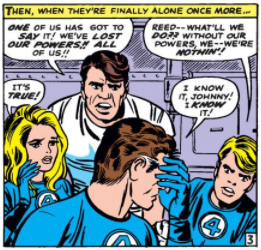 Once this revelation is out of the way we skip forward to Reed Richard's lab some time later (rendered with a fabulous Kirby Photo Montage) where he's developing artificial ways to replicate their powers. The results are not much cop, with a re-humanised (NB this is a genuine word, don't worry about looking it up) Ben Grimm being unable to control a special Thing Robot, and the others not having much luck either. There's some highly enjoyable character work here, with Reed Richards losing patience with the efforts of the others. They're all understandably worried though - what would happen if their enemies were to find out they'd lost their powers?
Once this revelation is out of the way we skip forward to Reed Richard's lab some time later (rendered with a fabulous Kirby Photo Montage) where he's developing artificial ways to replicate their powers. The results are not much cop, with a re-humanised (NB this is a genuine word, don't worry about looking it up) Ben Grimm being unable to control a special Thing Robot, and the others not having much luck either. There's some highly enjoyable character work here, with Reed Richards losing patience with the efforts of the others. They're all understandably worried though - what would happen if their enemies were to find out they'd lost their powers?
At this poignant moment we drop in on their greatest nemesis, Doctor Doom, who is relaxing at home by watching a hypnotist levitate a man with a concrete block on his front.
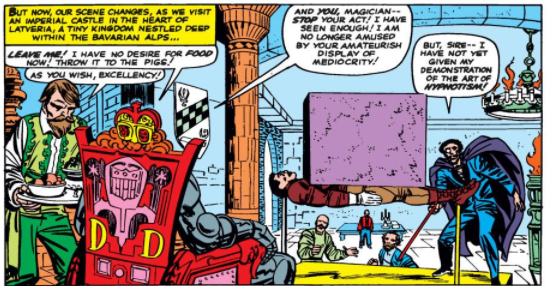 In later years, of course, Latveria would get Netflix and put such artisans out of work. This is the first time that Latveria has appeared in the main Fantastic Four series, having only appeared once before in
In later years, of course, Latveria would get Netflix and put such artisans out of work. This is the first time that Latveria has appeared in the main Fantastic Four series, having only appeared once before in 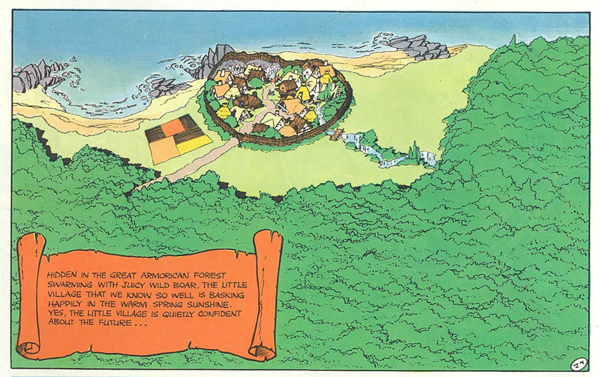 The hypnotist tries to impress his employer by using his mesmeric power on Doom, which I would have thought was a risky strategy. Victor does not seem the sort to laugh at a video of himself pretending to be a chicken. However, this has the unexpected result of removing the hypnotic suggestion implanted in his brain last time we saw him, and he realises that he never defeated Reed Richards at all!
The hypnotist tries to impress his employer by using his mesmeric power on Doom, which I would have thought was a risky strategy. Victor does not seem the sort to laugh at a video of himself pretending to be a chicken. However, this has the unexpected result of removing the hypnotic suggestion implanted in his brain last time we saw him, and he realises that he never defeated Reed Richards at all!
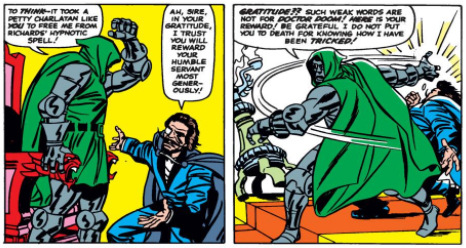 Doom is, understandably, livid, and the fact that a "petty charlatan" revealed the truth to him doesn't go down well either. Doom always claims to be working for the good of the Latverians, but he's never worried about taking his frustrations out on the bearers of bad news, and here he slaps the hypnotist in the face before jumping into a gyroscopic aircraft and heading to New York to take his revenge.
Doom is, understandably, livid, and the fact that a "petty charlatan" revealed the truth to him doesn't go down well either. Doom always claims to be working for the good of the Latverians, but he's never worried about taking his frustrations out on the bearers of bad news, and here he slaps the hypnotist in the face before jumping into a gyroscopic aircraft and heading to New York to take his revenge.
Once he arrives he manages to take over the Baxter Building while The Fantastic Four are away, hiding out in a warehouse trying to get their artificual superpowers to work. Luckily for them their lawyer, Matt Murdock, is visiting, so when Doctor Doom finds out where they are and starts shooting lazers Murdock is able to slip into his other identity of Daredevil to help them out. He's has been their lawyer ever since he stopped Electro from taking over the Baxter Building - a fact I know for sure because Matt Murdock thinks it and then a citation is provided by one of the handy footnotes that litter this story.
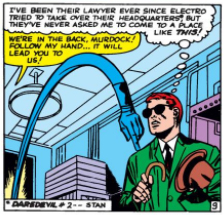 I've noticed these appearing more and more as we move forward with these stories, as Lee and Kirby start to revel in the complexity of the universe they're creating by pointing out to readers how clever they're being. It's an example of a fictional universe being used to enrich the storytelling, rather than control it. If the Fantastic Four need a lawyer, why not make it a character who already exists, and has his own backstory? As we'll see in a few blogs' time, this will have implications both for the Fantastic Four series and for Daredevil's own titles, allowing the character of Doom to develope relationships that will cause him to begin to travel much more widely around the Marvel Universe.
I've noticed these appearing more and more as we move forward with these stories, as Lee and Kirby start to revel in the complexity of the universe they're creating by pointing out to readers how clever they're being. It's an example of a fictional universe being used to enrich the storytelling, rather than control it. If the Fantastic Four need a lawyer, why not make it a character who already exists, and has his own backstory? As we'll see in a few blogs' time, this will have implications both for the Fantastic Four series and for Daredevil's own titles, allowing the character of Doom to develope relationships that will cause him to begin to travel much more widely around the Marvel Universe.
Doctor Doom proceeds to use several of Reed Richards' inventions against him. The four are helpless to fight back, so Daredevil has to protect them by leaping about, distracting Doom, and shoving the FF out of the way of incoming Fantasticars. The Fantastic Four appear to be fascinated by Daredevil's abilities, constantly going on about how agile he is and how he seems to have extra senses, which is exactly what he does have. They are superheroes themselves, so it seems a bit dim not to consider the idea that he might have superpowers too.
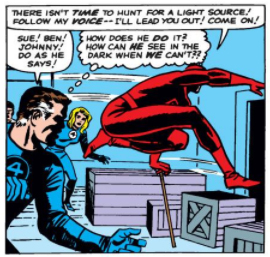 Mind you, they're not the only ones. Doom is utterly perplexed by the way the FF don't fight back, and can't work out what's going on despite the fact that he can clearly see Ben Grimm, who he went to college with, running around with them instead of the Thing. Eventually he works it out, and decides to uses Reed's television monitoring screens to wipe them out.
Mind you, they're not the only ones. Doom is utterly perplexed by the way the FF don't fight back, and can't work out what's going on despite the fact that he can clearly see Ben Grimm, who he went to college with, running around with them instead of the Thing. Eventually he works it out, and decides to uses Reed's television monitoring screens to wipe them out.
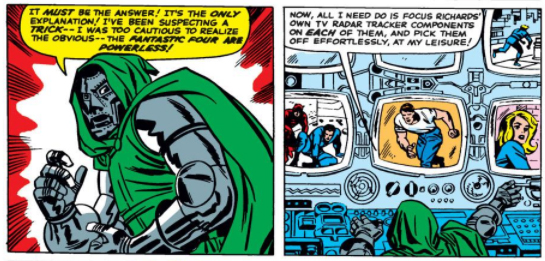 In earlier issues I'd noted how often TV screens are used as part of the plot. This seems to have eased off now, but it's still nice to see Doctor Doom pre-empting Ozymandias in Watchmen by a few years. This seems like a good plan, but he quickly decides that it would be too easy, and that he'd rather spread the fun out a bit more. This is another constant in Doom's character - the need to relish his victory, rather than actually have a victory. You'd think he'd have learnt how this always goes by now, but no, he decides to carry on harrying them with another of Reed's devices.
In earlier issues I'd noted how often TV screens are used as part of the plot. This seems to have eased off now, but it's still nice to see Doctor Doom pre-empting Ozymandias in Watchmen by a few years. This seems like a good plan, but he quickly decides that it would be too easy, and that he'd rather spread the fun out a bit more. This is another constant in Doom's character - the need to relish his victory, rather than actually have a victory. You'd think he'd have learnt how this always goes by now, but no, he decides to carry on harrying them with another of Reed's devices.
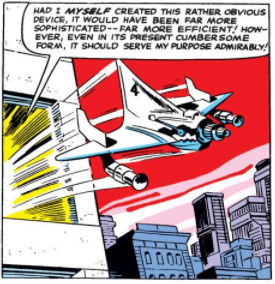 I love the fact that he critices the design of the Force Beam Projectile here - he'd have made a much better one. He keeps saying that he is Reed Richards' "equal" here, but clearly he thinks he's more than that. This obsession with Reed, rather than any of the rest of the Fantastic Four, is now a core part of Doom's personality, and it's something that will never really change.
I love the fact that he critices the design of the Force Beam Projectile here - he'd have made a much better one. He keeps saying that he is Reed Richards' "equal" here, but clearly he thinks he's more than that. This obsession with Reed, rather than any of the rest of the Fantastic Four, is now a core part of Doom's personality, and it's something that will never really change.
The story ends with the Fantastic Four splitting up, deciding to try and get into the Baxter Building from different angles while Daredevil distracts him. Jack Kirby draws this as a quick succesion of character shots, showing Daredevil and each of the four at the same moment, preparing to make their move.
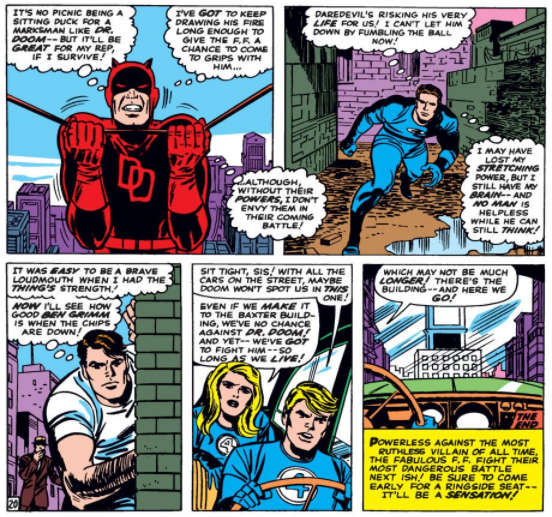 It's a supremely exciting way to ramp up the tension, to such an extent that the first time I read this issue I let out a yelp of frustration because the story had ended. Some of the earlier issues covered in this blog did, I must admit, feel a bit cumbersome and old fashioned, but this one was a joy to read. When's the next one?!?
It's a supremely exciting way to ramp up the tension, to such an extent that the first time I read this issue I let out a yelp of frustration because the story had ended. Some of the earlier issues covered in this blog did, I must admit, feel a bit cumbersome and old fashioned, but this one was a joy to read. When's the next one?!?
(in just two day's time, that's when!)
link to information about this issue
posted 21/3/2018 by Mark Hibbett
| < previous | next > |
Comments: